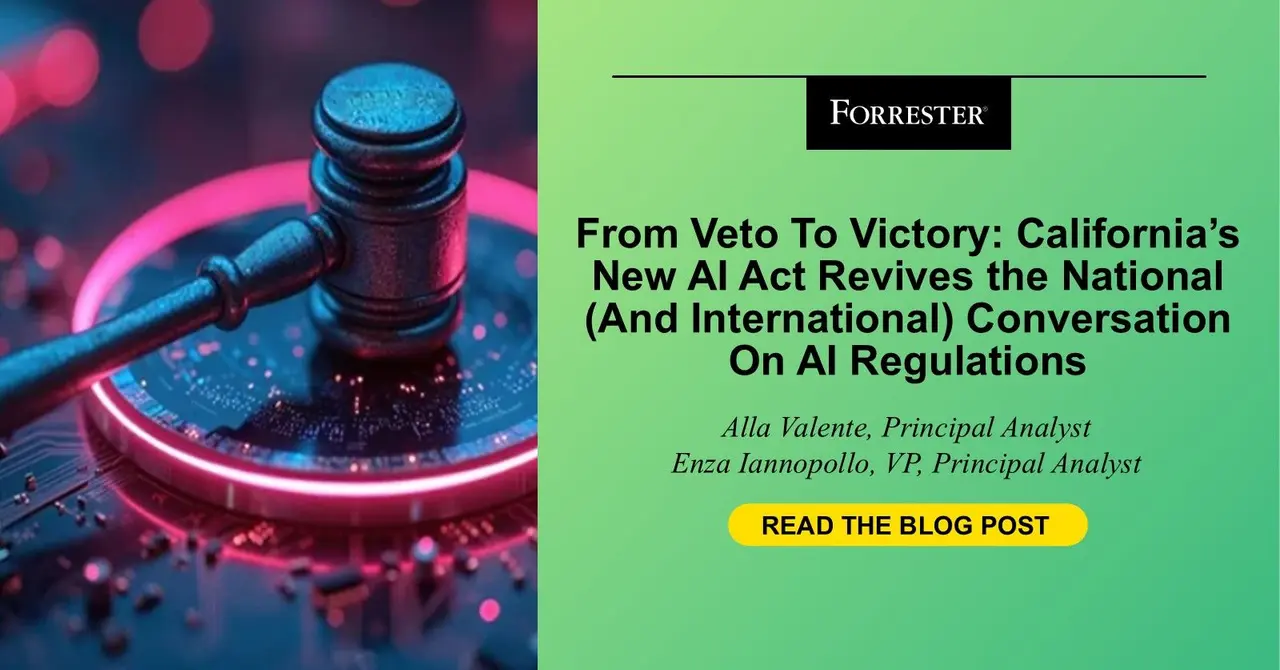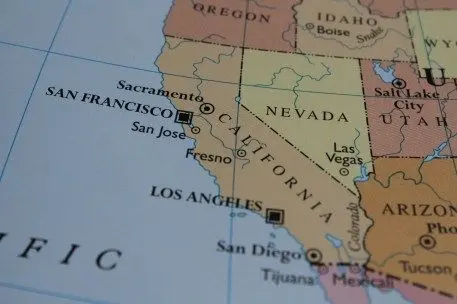California Leads the Way in AI Regulation with Comprehensive New Laws
2 Sources
2 Sources
[1]
From Veto To Victory: California's New AI Act Revives the National (And International) Conversation On AI Regulations
Defying the odds and lobbying pressure, California's SB 53, known as the Transparency in Frontier AI Act (TFAIA), is now officially a law and new framework for AI policy nationwide. With Governor Newsom's signature, California not only contributes to define what responsible AI governance could look like, it also proves that AI oversight and accountability can achieve (at least some) industry support. Unlike its predecessor (SB 1047), vetoed a year ago for being too prescriptive and stringent, TFAIA is laser-focused on transparency, accountability, and striking the delicate balance between safety and innovation. This is particularly critical considering the state is home to 32 of the top 50 AI companies worldwide. TFAIA Finds the Illusive Middle Ground At its core, TFAIA requires safety protocols, best practices, and key compliance policies, but stops short of prescribing risk frameworks and imposing legal liabilities. Here's a closer look at what's in the new AI law: * Transparency. This law applies to large developers of frontier AI models with revenue exceeding $500 million must now publicly share detailed frameworks describing how their models align with national and international safety standards and industry best practices. Companies that deploy AI systems, companies that use AI, users of AI products, and small AI developers are not subject to these requirements. * Public-facing disclosure. Disclosures of general safety framework(s), risk mitigation policies, and model release transparency reports must be made available on the company's public-facing website to ensure safety practices are accessible to both regulators and the public. * Incident Reporting. The law mandates reporting of critical safety incidents "pertaining to one or more" of its models to California's Office of Emergency Services within 15 days. Incidents that pose imminent risk of death or physical injury must be disclosed within 24-hours of discovery to law enforcement or public safety agencies. * Whistleblower Protections. It expands whistleblower protections, prohibits retaliation, and requires companies in scope to establish anonymous reporting channels. The California Attorney General will begin publishing anonymized annual reports on whistleblower activity in 2027. * Supports innovation through "CalCompute." The law establishes "CalCompute," a publicly accessible cloud compute cluster under the Government Operations Agency. Its goal is to democratize research, drive fair competition, and foster development of ethical and sustainable AI. * Continuous improvement. The Department of Technology is tasked with annually reviewing and recommending updates, ensuring that California's AI laws evolve at the speed of innovation and adapting to new international standards. Another Blueprint For States With no foreseeable path to a US federal policy, and following Meta's announcement of a super PAC to fund state-level candidates that are sufficiently pro-AI (sufficiently against AI regulations), the battle over regulating AI is at the state level, not Congress. With TRAIA, California sends a clear message that states now own the responsibility and capacity to set meaningful standards for AI. And they can do so without sacrificing innovation, growth, or opportunity. California Ends The "Stop-the-clock" Rhetoric California's newly adopted AI legislation breaks the spell of the regulation "slow down and wait" narrative. It shows regulation and successful AI development don't just coexist; they reinforce each other. Expect this new bill to puncture the "stop the clock" rhetoric and spur more governments to get serious about their own AI rules. Companies Will Have To Monitor And Pay Attention The three major state AI laws passed so far vary in focus and intent. California's (TFAIA) focused on transparency, Colorado's Artificial Intelligence Act (CAIA) targets high risk applications and consequential decisions especially for consumers, while Texas' Responsible Artificial Intelligence Governance Act (TRAIGA) concentrates on prohibiting harmful uses of AI particularly for minors. Organizations operating across state lines will need to carefully monitor these and any new laws as they'll need to comply with all states' unique requirements. If you are a Forrester client, schedule a guidance session with us to continue this conversation and get tailored insights and guidance for your AI compliance and risk management programs.
[2]
California Tops States for AI and Social Platforms Accountability Rules | PYMNTS.com
By completing this form, you agree to receive marketing communications from PYMNTS and to the sharing of your information with our sponsor, if applicable, in accordance with our Privacy Policy and Terms and Conditions. Governor Gavin Newsom this month signed five bills addressing child online safety and AI accountability, introducing new standards for chatbot oversight, age verification and content liability. The laws mark the most comprehensive attempt yet by a U.S. state to regulate how generative AI and social platforms interact with users. According to California's official announcement, the legislation creates new guardrails for technology companies, including requirements for chatbot disclosures, suicide-prevention protocols and social media warning labels. The Companion Chatbot Safety Act (SB 243) mandates that AI "companion chatbot" platforms detect and respond to users expressing self-harm, disclose that conversations are artificially generated, and restrict minors from viewing explicit material. Chatbots must remind minors to take a break at least every three hours, and beginning in 2027, they must publish annual reports on safety and intervention protocols. As PYMNTS reported, the new rules follow mounting concerns about AI's psychological impact on young users and the increasing use of chatbots for emotional support. Another measure, AB 56, requires social media apps such as Instagram and Snapchat to display mental health warnings, while AB 1043 compels device makers like Apple and Google to implement age-verification tools in their app stores. The deepfake liability law (AB 621) strengthens penalties for distributing nonconsensual sexually explicit AI-generated material, allowing civil damages up to $50,000 for non-malicious and $250,000 for malicious violations. Separately, the Generative Artificial Intelligence: Training Data Transparency Act (AB 2013) as covered by PYMNTS, will take effect on January 1, 2026, requiring AI developers to disclose summaries of the datasets used to train their models. Developers must indicate whether data sources are proprietary or public, describe how information was collected, and make this documentation publicly available. The business implications for major technology firms are immediate, given that many of the affected companies, including OpenAI, Meta, Google and Apple, are based in California. CNBC reported that OpenAI called the legislation a "meaningful move forward" for AI safety, while Google's senior director of government affairs described AB 1043 as a "thoughtful approach" to protecting children online. Analysts said the rules are likely to have a distributed impact, as all companies must comply simultaneously. The state's regulatory momentum mirrors a broader global tightening of AI oversight. The European Union's AI Act imposes fines for risk violations, and U.S. states such as Utah and Texas have passed age-verification and parental-consent laws. In California, momentum could build further: Politico reported that former U.S. Surgeon General Vivek Murthy and Common Sense Media CEO Jim Steyer launched a "California Kids AI Safety Act" ballot initiative that would require independent audits of youth-focused AI tools, ban the sale of minors' data and introduce AI literacy programs in schools. California's legislative package represents a structural shift in how governments define AI accountability. A CNBC-cited survey found that one in six Americans rely on chatbots for emotional support, and more than 20% say they've formed personal attachments to them -- a sign that digital interactions are becoming psychologically significant. That reality is pushing lawmakers to expand compliance frameworks beyond privacy and content moderation toward behavioral safety and liability. For enterprises, the new standards could accelerate the adoption of "safety by design" principles and make compliance readiness a prerequisite for market entry. Companies able to demonstrate responsible data use and transparent model documentation may gain a competitive advantage as regulators and consumers scrutinize AI governance practices more closely. For policymakers and investors, the framework illustrates how innovation ecosystems are evolving under a new premise: that long-term growth in AI depends on public trust and verifiable safety. As Newsom said, "Our children's safety is not for sale." With that position now enshrined in law, California is setting a benchmark for AI accountability that other jurisdictions are likely to follow.
Share
Share
Copy Link
California has passed groundbreaking legislation to regulate AI and social media platforms, focusing on transparency, safety, and accountability. These laws set new standards for AI governance and child protection online.
California's Pioneering AI Legislation
California has taken a significant step forward in regulating artificial intelligence (AI) and social media platforms, positioning itself as a leader in the ongoing debate over AI governance. Governor Gavin Newsom recently signed a package of bills that introduce comprehensive measures to ensure transparency, safety, and accountability in the AI industry
1
2
.
Source: Forrester
The Transparency in Frontier AI Act (TFAIA)
At the heart of California's new AI regulatory framework is the Transparency in Frontier AI Act (TFAIA). This law requires large AI developers with revenue exceeding $500 million to publicly disclose their safety frameworks, risk mitigation policies, and model release transparency reports
1
. The TFAIA strikes a balance between safety and innovation, focusing on transparency and accountability without imposing overly prescriptive risk frameworks or legal liabilities.Key Provisions of the New Laws
-
Incident Reporting: Companies must report critical safety incidents within 15 days, with a 24-hour reporting requirement for incidents posing imminent risk of death or physical injury
1
. -
Whistleblower Protections: The legislation expands protections for whistleblowers and mandates anonymous reporting channels
1
. -
CalCompute: A publicly accessible cloud compute cluster will be established to democratize AI research and foster ethical AI development
1
. -
Chatbot Safety: The Companion Chatbot Safety Act (SB 243) requires AI chatbots to detect and respond to users expressing self-harm, disclose their artificial nature, and implement safeguards for minors
2
. -
Social Media Regulations: New rules mandate mental health warnings on social media apps and age-verification tools in app stores
2
. -
Deepfake Liability: Stricter penalties have been introduced for distributing nonconsensual, AI-generated explicit material
2
.
Related Stories
Impact on the AI Industry
These laws have significant implications for the AI industry, particularly as many major tech companies are based in California. The legislation has received cautious support from some industry leaders, with OpenAI calling it a "meaningful move forward" for AI safety
2
.
Source: PYMNTS
A Model for Future Regulation
California's approach could serve as a blueprint for other states and potentially influence national and international AI regulations. The legislation challenges the "stop-the-clock" rhetoric often used to delay AI regulation, demonstrating that effective oversight and successful AI development can coexist
1
.As the AI landscape continues to evolve, California's new laws represent a significant step towards ensuring responsible AI development and deployment, with a focus on transparency, safety, and public trust.
References
Summarized by
Navi
[1]










